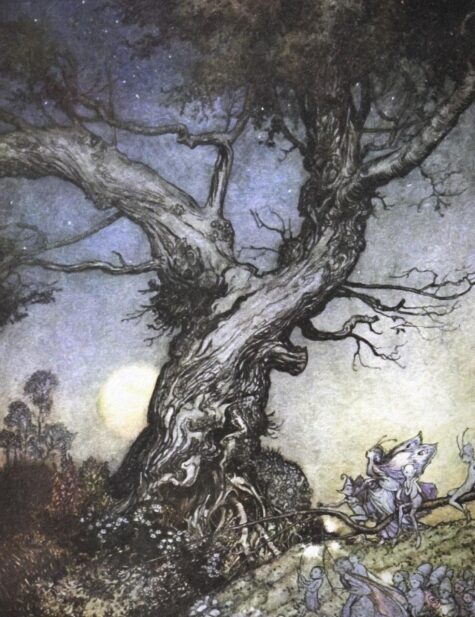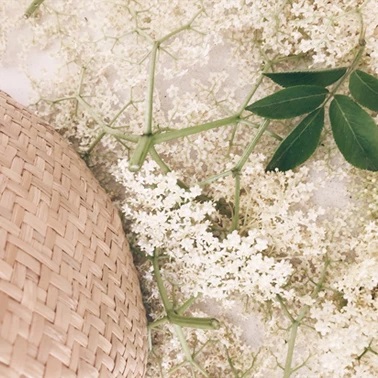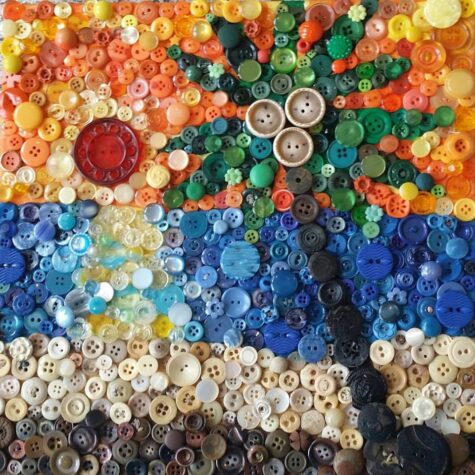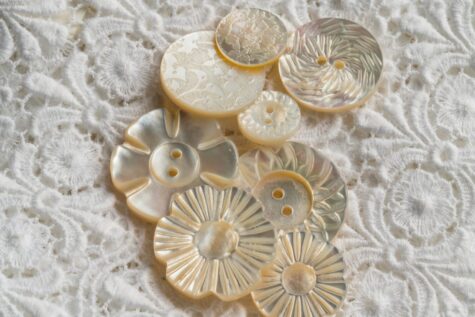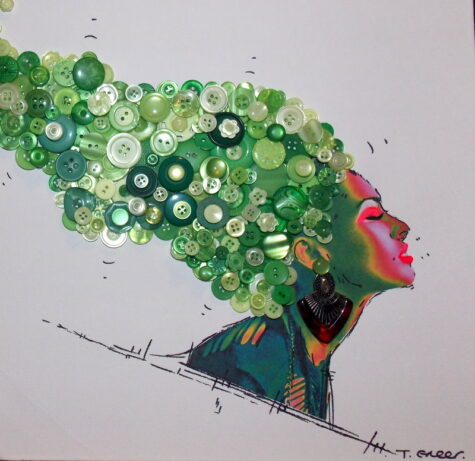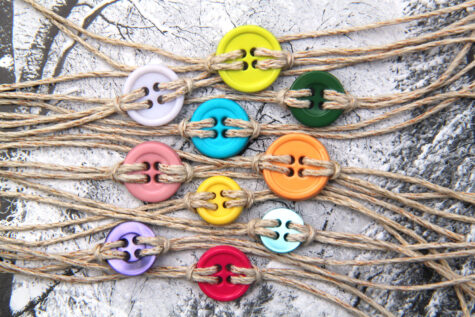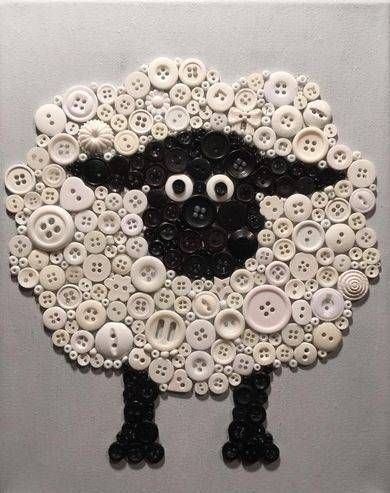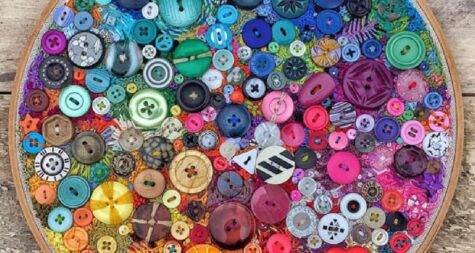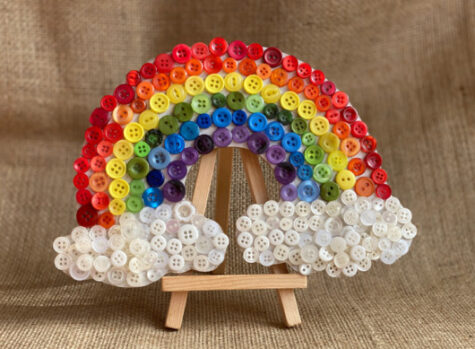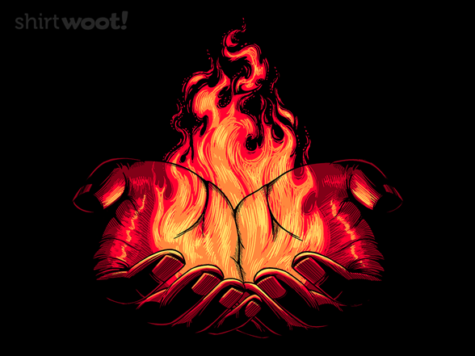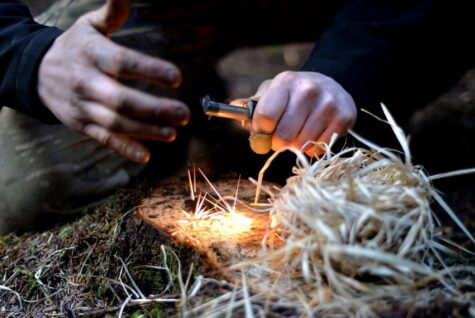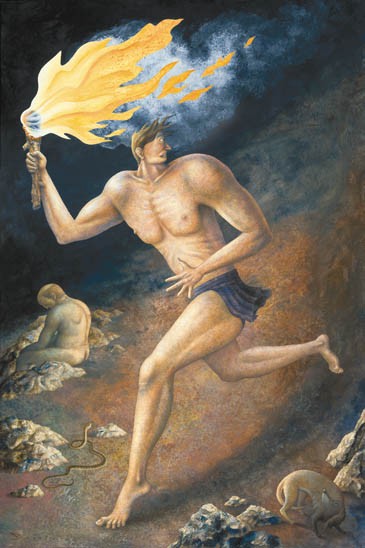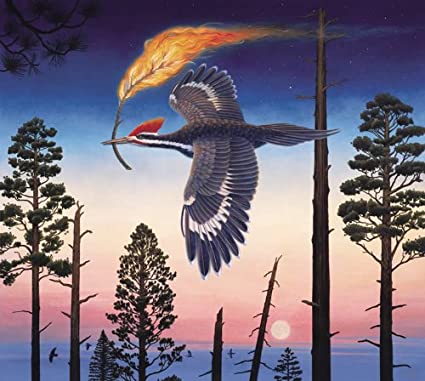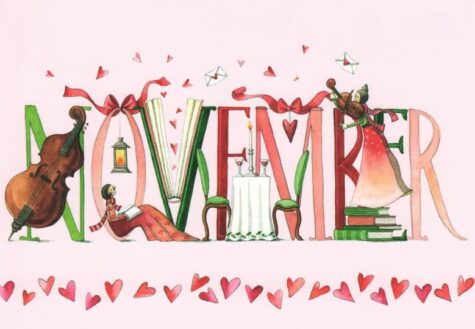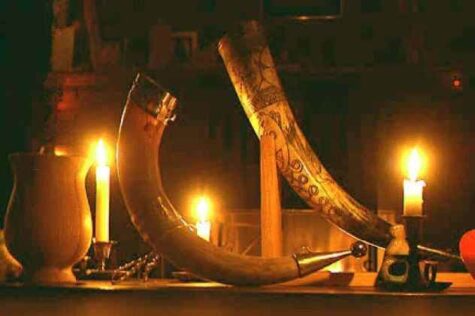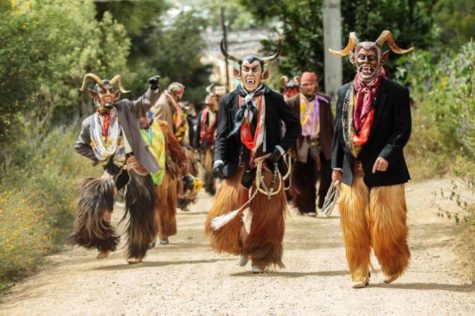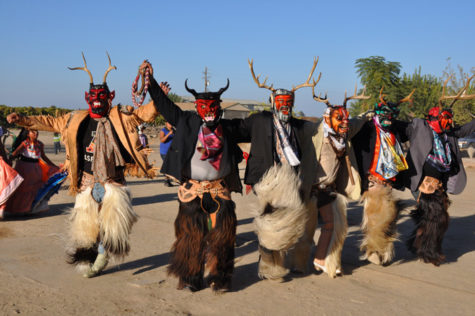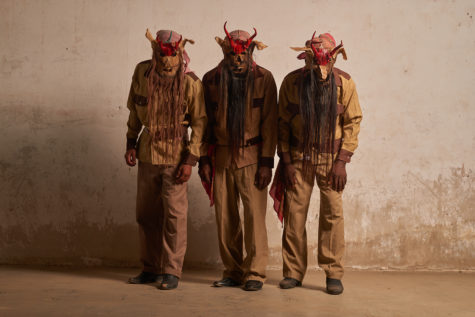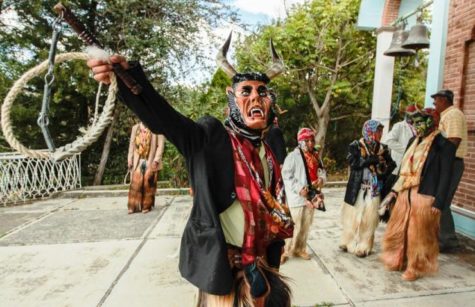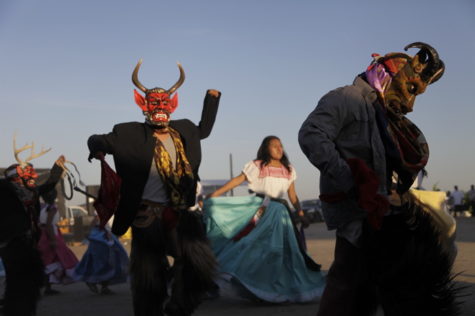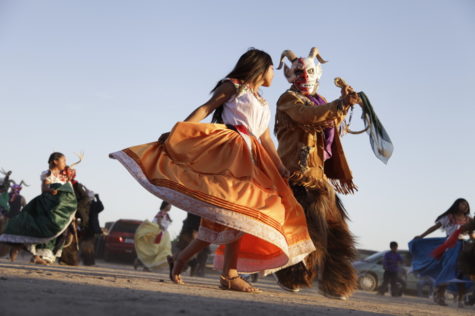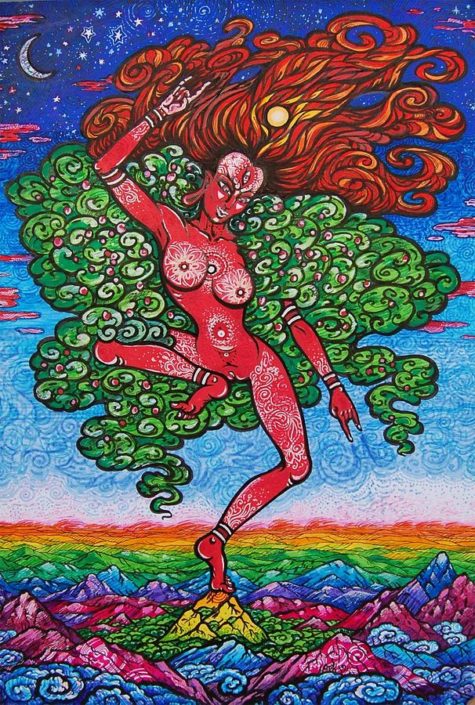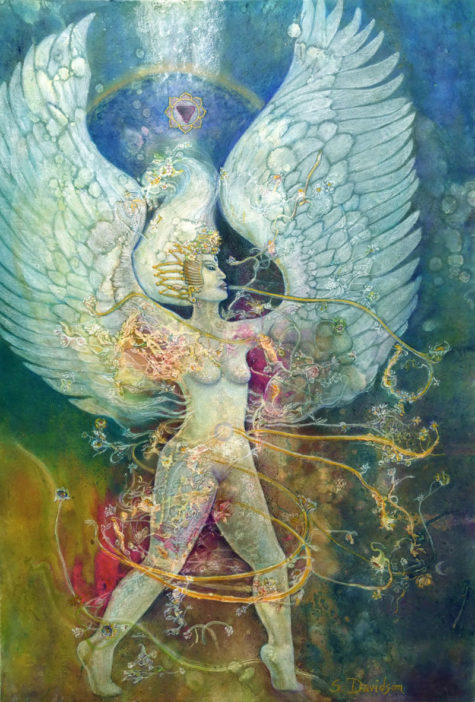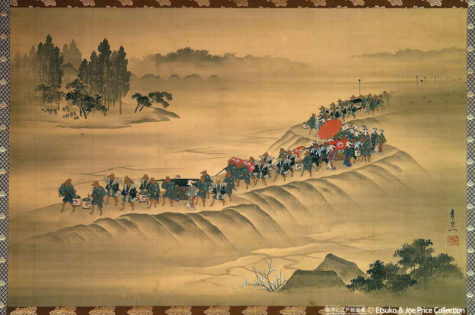November
The Elder Month is the last month in the cycle of the 13 Celtic months, and it indicates the renewal of energy and the continuous journey of the soul towards greater happiness and understanding. The Winter Solstice, the shortest day and longest night, occurs during the Elder Month, and offers the chance to focus on your heart’s desire.
- Dates: November 24 – December 22
- Celtic / Oghum Name: Ruis (pronounced roo-esh)
- Language of Flowers: Zealousness
- Qualities: Regeneration, Fertility, Healing, Otherworld, Balance, Wisdom, Knowledge, Calm, Winter, Witches, Wise Women, Cooling, Fairies, Crone Goddess
- Themes: Endings, Rebirth, Creativity, Renewal, Protection, Magick
The winter solstice has passed, and the Elder month is a time of endings. Although the Elder can be damaged easily, it recovers quickly and springs back to life, corresponding to the approaching New Year. The month of Elder is a good time for workings related to creativity and renewal. It is a time of beginnings and endings, births and deaths, and rejuvenation.
The Druids believed that it was during this period that their Sun or Solar Spirit was being held prisoner. It was also considered a time of trouble and indicative of the struggle for supremacy.
The Elder Moon is a time to bring a halt to habit-forming patterns that have been restricting your growth, so that you may heal and move on. Evaluate what you have learned during the past year and give yourself time to work out what you really want from life. Draw upon energy that concludes the annual cycle and release the energy you have invested in previous projects and endeavors, so that you may concentrate on conceiving your new dreams for the New Year.
Use the powers of the elder tree to bring a sense of completion to the old year and a feeling of renewal for the start of the next cycle. Try these simple rituals to bring a sense of completion to your Celtic lunar year.
- Review the last 13 Moon, writing down what you have learned from each. Acknowledging your lessons will help you move on.
- Areas of your life that feel unfulfilled indicate stuck energy. Hold a quartz crystal and direct love towards your current job, cramped flat, or credit card bill. New opportunities will appear as if my magic.
- Resolve difficult relationships by writing a letter to the soul of the person with whom you are in conflict. This helps to clear the way for change. Then burn the letter.
Elder the Seeker
The last in the Celtic tree astrology pantheon is the Elder tree sign. People from this sign love freedom and others may see them as wild and untamed. The slogan of their life is “Live fast”, always seeking thrills and adventures. They are often misunderstood and treated as outsiders, even though they are extroverts by nature. However, the Elder signs can be deeply thoughtful, often very considerate of others and love to lend a helping hand. This misjudged sign fits well with the Alder and Holly signs.
The Elder individual evolves gradually during his or her lifetime. In youth, such people are inclined to waste much time and energy on worthless ventures or projects. They are often fortunate individuals who frequently benefit at an early age from inheritances. However, this usually only encourages their extravagant tastes and indulgences.
With a basic restlessness and/or insatiable curiosity, Elder individuals are drawn into the study of profound subjects and are prone to travel great distances in order to further their knowledge. Elder individuals are self-sufficient, lively and outspoken. They dislike routine and refuse to be pressured by others. Highly energetic with a great deal of stamina, they thrive on change and crave constant mental and physical challenge.
In later life, the Elder individual commands respect and possesses a great deal of patience. Elder characters are often outspoken and prone to speak without first thinking, but they possess a constructive approach to life and are frequently drawn to careers in the military or journalism.
The true strength of Elders lie in the instinctive knowledge of when they are right and others are wrong, coupled with their inherent inclination toward self-discipline. The Elder individual is open in his or her relationships, but tends not to fall in love very deeply, seemingly able to remove their emotions from most situations.
While finding it difficult to tame their restless natures enough to take on parenthood, Elders do make wonderful uncles and aunts. It is important that Elder individuals learn to use change as a positive force in their lives in order to avoid becoming reckless and confused.
Elder Magick and Lore
Elder symbolizes judgement, transformation, death and regeneration, and fate. It is known as the Queen of all Herbs and rightly so; all parts of the Elder can be used medicinally. The lesson of the Elder is a difficult one but important and inevitable. It presents us with a looking glass into our own lives where we are faced to answer difficult questions about how we lived our lives and how we will be remembered; this was especially important to Celtic warriors.
Elder is also said to protect against demons and other negative entities. Use in magic connected to Faeries and other nature spirits.
Often planted close to the home, the Elder was thought to offer protection against evil influences and lightning…based on the fact that the tree itself never seemed to get struck and it was hoped such immunity would extend to the nearly dwellings. In ancient times, it was believed that negative forces would be attracted by someone who fell asleep beneath an Elder tree. While slumbering, it was thought such a person would suffer horrific nightmares and become delirious upon waking.
The elder tree’s ability to recover when damaged has made it a symbol of regeneration since ancient times and for this reason it was used in burial rites in British longbarrows (an ancient style of grave). Due to to its white flowers (life) and black berries (death), the tree is also sacred to the Mother Goddess who governs birth and death.
The wood of elder is believed to have protective properties because of the powerful Dryad spirit that lives within it. When planted near a home, the tree will ward off intruders. The healing powers of the elder are also thought to cure insomnia (by placing elderberries in a bad under a pillow) and ensure the health of unborn babies (when pregnant women kiss its bark).
To Release Negativity
Upon reaching the end of the Celtic calendar, the Elder Moon month is the perfect time to release negative energies before entering the New Year, feeling renewed.
Dig a hole in the ground and say, “Mother Earth, I ask you to transform my pain into healing.”
Place a photo of yourself and a drawing, or written account, of any negative incidents into the hole. Speak or shout your feelings into the hole.
When you feel ready place an elder twig into the hole to represent the end of the cycle. Fill in the hole and stamp the earth down three times saying, “I release the past, so mote it be.”
Sources:
National Button Day on November 16th celebrates the function of buttons and the hobby of button collection. Buttons are so commonly found in our clothing that we tend to take them for granted. Buttons have various functions other than just keeping our clothes perfectly together, not denying that it is an important function. They have been used for decorative and gaming purposes as well.
Some people just like to collect buttons for their sparkle and cuteness and others collect signature buttons that have been somehow important to them. There are thousands of button collectors in the United States. Crafters across the country utilize buttons in creative ways. They are some of the best at finding new uses for old items.
Buttons come in different materials, patterns, designs, and sizes. Buttons have been made of a variety of materials. Ancient buttons were formed from natural and readily available substances such as stone, shell, bone, clay, or wood. In more modern times, metals, plastics, resins, and acrylics have been used. While buttons were created to fasten two pieces of cloth together, they also served as decoration.
While buttons today can be simple disks with two or four holes allowing a needle and thread to pass through, button makers create more elaborate designs. If you can imagine it, there’s probably a button like it. From animals and food to iconic buildings and famous people, button makers make them. They’re colorful and fun. While the fun ones may be less practical, they still function.
The origin of buttons can be traced back to 2800 BC where shells were used for making ornaments and seals. However, the buttonholes with buttons as fasteners first emerged in Germany and from there, spread throughout Europe. The buttons were made using the popular materials available during that period. Today, we see buttons mostly made of plastic, metal, wood, or seashells.
Why National Button Day?
The National Button Society was founded after the Hobbies Magazine conducted a hobby show in 1938 and found many participants to be button collectors and thus the National Button Day. Both novice and advanced button collectors celebrate the enjoyment of collecting on this day.
The appeal of buttons is clear. They come in every shape, color and style, from pearly white shirt buttons, to ornate Victorian affairs, to cute fastenings shaped like insects and animals. Any outfit can be updated by adding the right buttons, and sewing them on is one of the easiest types of needlework to learn. And they don’t just belong near buttonholes, either. Clusters of buttons can be used to decorate almost everything, and even on their own in jars they are delightful to handle, play with and admire. Some collect them, but most just lose them. Regardless, nearly everyone seems to love them, or at least regard them with fascination.
In case you may be thinking that buttons do not deserve their own holiday, try to imagine what life would be like without them. Sure, we have zippers and velcro, but could you imagine velcro down the front of your elegant blouse? Of course not!
A Short History of Buttons
It took the buttonhole to popularize the button in medieval Europe. Buttonholes were invented by Moorish tailors as a means of fastening garments and adopted in Europe in the 13th century. Then buttons became so prominent that in some places sumptuary laws were passed putting limits on their use. The earliest evidence comes from 13th-century German sculptures, which show tunics featuring six buttons running from neck to waist.
Buttons in fourteenth century Europe were hand-made in beautiful shapes and colors. They were both costly and decorative and used to boost the ego and attract attention. John Brandon, for example, who died in 1384, was shown with 40 buttons on the sleeve of his undervest alone.
The wearing of gold, silver, and ivory buttons in fourteenth century Europe was an indication of wealth and rank. Expensive buttons were also made of copper and its alloys. The metalsmith frequently embellished such buttons with insets of ivory, tortoiseshell, and jewels.
There was a button mania in the late Middle Ages, resulting, in some outfits adorned with thousands of buttons, all of them with accompanying buttonholes. Dressing and undressing became a laborious process, but created a niche for the employment of professional dressers.
In the 15th or 16th century someone discovered that a loop slipped over a button, or a button pushed through a slit in the cloth, made a better fastener for the close-fitting garments that were coming into style. For some time, however, the chief use continued to be ornamental.
The asymmetrical fastening of jackets of the wrap over style came into fashion in China during the 15th and 16th centuries and was worn by men and women, royalty and peasants. It was the material and the buttons that showed rank. Peasants wore rough cloth fastened with anything that came to hand while the emperor wore silk and furs fastened with jewels.
In the 1700’s metal buttons were used and button covering was created. Metal threads were wound about a button in intricate patterns. Miniature scenes were painted on ivory or glass buttons. Some buttons were engraved and inlaid with silver.
Frederick the Great organised the buttons on soldiers’ coat sleeves being sewed on the top sides of their sleeves. This was to ensure that the soldiers would scratch their faces open every time they tried to wipe their noses on their tunics.
In the middle of the 18th century, Matthew Boulton, the English manufacturer and partner of James Watt, introduced the bright, costly, cut-steel button, which was made by attaching polished steel facets to a steel blank. Matthew Boulton built the Soho manufactory near Birmingham. The factory produced small metal articles such as gilt and silver buttons and buckles.
Noting the abundance of pearl mussels in the nearby Mississippi River, German immigrant J.F. Boepple, founded a pearl button company in 1884 Muscatine, Iowa He produced buttons that looked like pearls by machine-punching them from freshwater mussel shells harvested from the Mississippi River. His button-making factory grew to be the largest manufacturer of pearl buttons in the world. From that time forward, Muscatine was known as “The Pearl Button Capital of the World”.
Celebrating Button Day
Take some time on this day to either go though your existing button collection or start a new one, and enjoy Button Day to the fullest! Who knows, perhaps you possess in your collection an antique button that’s been passed down for so long that you’ve never stopped to think about where it came from. Keep your eyes open! Every now and them someone discovers a treasure that had just been sitting around collecting dust at their home. And even if you don’t, an all you have is regular buttons, don’t worry and just enjoy an afternoon looking at the pretty, shiny little things. At the end of the day, people are animals, and there’s nothing animals like better than something pretty and shiny.
- Take a trip down memory lane.
Do you remember your grandmother or your mother snipping the buttons off shirts headed for the rag basket? Those buttons often collected in jars or tins. Maybe you even played games or strung them for ornaments and crafts. The buttons were fun to stack into piles, sort by color or size, or scatter and slide across the floor or table making up different games each time.
- Begin a button collection.
If you like buttons and didn’t have a chance to collect buttons before, you can observe the day, by collecting your first set of buttons either from your old shirts or get a few nice ones from the store!
- Show your button collection on Social Media
If you have already been collecting Buttons share your collection on Social Media using the following hashtags: #NationalButtonDay and #ButtonDay
- Craft your way with buttons!
If you love designing or making crafts, use buttons to make a unique craft today! You could make anything from greeting cards, posts to toys depending on the colors and size of the buttons! You may look up the internet for other activities too.
- Learn to sew a button!
Another best and productive way to celebrate your love for buttons is by learning to sew on of them. You never know, when this skill might come in handy!
- Play a game with buttons
Play a game with buttons, such as tic tac toe or even checkers. You can also have a contest as to who can build the tallest stack of buttons, or who can flick buttons into paper cups from the farthest distance.
- Visit a buttons museum
Use this day to visit a local museum that displays their button collection! A few museums have an online display too such as the Victoria & Albert Museum, Hammond Turner & Sons, Smithsonian National Museum of the American Indian among many others.
Interesting Facts About Buttons
Men shirts have buttons placed on their right and the women have buttons placed on the left. There is a difference because mostly men dressed themselves using their right hands and the wealthy women were usually dressed with the help of maidens and the left side position of the buttons was necessary for doing it easily. The pattern is still followed today!
- In the ancient days, buttons were used as ornaments rather than as fasteners.
- The oldest ever button is found in Pakistan.
- The Waterbury Button Company has been the largest button manufacturer since 1812.
- New York is home to the largest button in the world.
- Joseph Coors Jr. created the indestructible diamond Z button which obviously must last longer and expensive.
- Before the 13th century, the use of buttons to fasten your clothing was taken as an indication that you led a loose life.
- Francis 1st of France (1494-1547) had 13,600 gold buttons on a single coat, which he wore when meeting King Henry VIII of England.
- King Louis XIV had a coat with 123 diamond buttons on it.
- Today, 60 per cent of the world’s buttons are made in one Chinese town, Qiaotou, which churns out 15 billion buttons a year.
- 1 in 75,000 people suffer from koumpounophobia, the fear of buttons.
- During World War II, Canada gave out buttons to people who tried to enlist but were refused due to medical reasons to show their willingness to fight.
Button Magick
Buttons are incredible little tokens much like coins or rocks that can be used for a plethora of fun and useful witchy crafts. They’re small, portable, wearable, transferable, and can be made easily or found for very little money at most thrift stores and craft shops!
Who knew buttons are magickal little tools? Our ancestors did, of course! Did your grandmother or aunt keep a tin or container of random buttons? Mine did and gifted to me. At the time, I wondered why a tin of buttons was so important. Now I know. If you were blessed with a tin of buttons from your family, keep it and make use of it!
- Ancestral work!
If anyone in your family has sewed they probably have a box/jar/tin of sewing supplies left around with some buttons in it! Use these on ancestral altars to again create that connection.
- Friendship spells!
Buttons are a kind of clasp or connection, therefore using buttons in spells for bonding can symbolize a connection, or clasp, of two or more people!
- A Button Magick Charm Necklace
Back in the day our ancestors collected and saved buttons. If you have a collection of buttons, you can make a magickal button necklace. Or what was once called a wishing necklace. For each button you string onto the necklace, pray over it your intention. Different colors for different intentions, etc. Make it fun and be creative!
- Divination.
Often buttons are used for eyes on dolls and stuffed animals and placing a button in front of you during a divination ritual can help you visualize and therefore open your third eye.
- Elemental Buttons
Buttons of certain materials can be used to harken back to certain elements, like clay or wooden buttons for Earth, or shell buttons for water.
- Altar Decorations
Buttons can be used as altar decorations, and larger buttons can act as tiny plates, display stands, or bases for mini offerings!
- Button Magic With Bags and Bottles
Buttons are great to add to shaker jars. When you shake the jar, they make awesome sounds! For me, part of the allure of a shaker jar is not only the prayer while shaking, but the sensory stimulation. The sounds release energy along with your prayers.
Also, buttons can be added to spell bottles and bags. Again, choose colors and styles matching your intentions. Think of the button’s job in the spell as “buttoning” up the situation.
- Sigils
Draw or paint sigils on the back of buttons with a sharpie and seal with some clear glue/resin. Sew them onto your shirt, bag, or thread them to wear as jewelry!
- A Declaration of Love
Japanese male students often confess their love to a female by giving them the second button from the top of their school uniform. The second button is the one closest to the heart.
Sewing Buttons With Intention
- To attract money – attach the button with the letter Z with a diagonal strip to the other side.
- For many fans – the stitches should be in the form of an hourglass: two horizontal stripes and the letter X in the middle.
- To strengthen friendship – an equal sign;
- Success in creativity – the letter A.
- Success in business – letter Z;
- Harmony with the outside world – a square;
- Gaining developed intuition – two vertical stripes;
- Health promotion – the cross;
- Increase of well-being – a cross and two verticals;
- For gaining passionate love – a cross and a square.
Button Superstitions
Buttons and the superstitions surrounding them are fascinating. While we tend to think very little about these ancient fasteners, our recent ancestors had a lot to say about the magick in buttons.
For example, it is believed that you cannot sew a button “on yourself” so as not to sew up the mind and memory . As an antidote, it is recommended to clamp a thread or other object between your teeth, even a piece of clothing.
Another belief says that sewing buttons on right before the New Year is not the best idea. Better to wait until the next day.
If you are preparing to meet a person who is unpleasant for you, then fasten all your buttons as tightly as possible. The buttons will work like a talisman and protect from any negativity coming your way.
Losing a button from your shoe is bad luck. The only way to get rid of the bad luck is to either spit in your left shoe or spit over your left shoulder.
Most people know that it is bad luck to do up buttons incorrectly. Fortunately, the remedy is easy; all you need to do is undo the buttons, take off the item of clothing, put it on again, and then do up the buttons correctly.
It is good luck to do up an odd number of buttons. If your garment has three buttons, for instance, you can do up either one or all three of them. However, if your garment has two buttons, you should do up the top button only, or leave the garment unbuttoned.
A seventeenth-century rhyme used for counting cherry stones, daisy petals, and other small objects was sometimes recited with buttons. Young women could count the buttons on their clothing to determine whom they would marry.
Tinker, tailor, soldier, sailor,
Rich man, poor man, beggerman, thief.
Like counting flower petals, girls would grab a handful of buttons and count them out to the “He loves me, He loves me not” chant. The last button gives the answer.
Make a wish over a button and throw it into a well. The well fairies like buttons and are said to grant wishes in exchange for a button or two.
- Should you find yourself sewing a button for a bachelor, you will marry him within the year.
- Putting old buttons on a new coat was considered bad luck.
- If a button pops off on a business suit, your luck in business is about to change.
- If three buttons fall off a garment, expect a funeral in the near future.
- A coat with eight buttons brings good luck.
- If someone is spreading lies about you, bite the top button of your shirt and the liar will get a blister on his tongue.
- Gifting buttons is to gift good luck. It brings the receiver good fortune.
The semantic meaning of the word “button” in Russia for many centuries consisted in the verb “scare”. The accessory, in addition to its utilitarian function, played the role of a talisman and served to scare off hostile forces. In the omen about the black cat that crossed the road, to neutralize the negative, you had to take the button and continue on your way. It was believed that this amulet would not allow anything bad to happen.
What does it mean to find a button?
Just because you come across a button, it doesn’t mean that you should pick it up. Everyone must decide for themselves, pick up a button or leave it on the road. A superstitious person will certainly pay attention to the number of holes.
Buttons with one or two holes should be left where they are. Especially destructive is the finding of a button with traces of thread still attached. Popular beliefs warn of imminent misfortunes for the one who appropriated this accessory, because all the illnesses and adversities of the previous owner will go to the one who picked it up.
An important factor will be the color scheme, which suggests that you can pick up only a button with four holes of any color except black.
If found on the street, then this is a good sign. This button portends luck in any undertakings, an easy way to fulfill wishes, the possibility of pleasant changes in life. Sometimes it is interpreted as a prediction of a long journey.
A button found in another busy place is also a good sign: on the verge of a change in life and a high appreciation of professionalism. It was also said that if you find a button while undertaking your daily tasks it is a sign that you’ll make a new friend.
If you find a button on the ground, and decide to pick it up and put it in your pocket, you will have good luck for as many days as the button has holes.
- Green is money.
- White is joy.
- Red is love.
- Blue is success.
- Black is grief.
If you came across a black button in your path, you should NEVER pick it up! It was a sign of bad luck or a curse.
It is especially lucky to find a button with four holes. If you find one, you can count on good news, and if the color of the button is white or green, then in addition to good news, you can expect cash receipts.
Finding buttons also holds different meanings based on which day of the month the button crossed your path.
- A finding in the first seven days of the month means that recognition of the person’s professional merits and his appointment to a new position is soon expected.
- In the second week – it promises good luck in love;
- In the third week – serves as a promise of change in personal life;
- At the end of the month – the possibility of large purchases and unexpected finds.
If a button with two holes is found – you should expect good news related to family or work. Possible unexpected financial receipts or a fundamental change in bachelor status.
On the road lies a talisman with four holes – a series of pleasant events and news awaits a person, and if you sew it in a secret place, the button will work to attract whatever is desired.
If you really want to pick up someone’s loss, pay attention to its color . According to popular beliefs, it predicts joyful or sad events that await in the near future:
If the button is still in the hands, then you can not keep it in your pocket – this will lead to a quarrel between friends or relatives. It is better to sew it on the wrong side of the garment, so that it will be closer to the heart, but invisible to others. Sewn in a special way, it will serve as a talisman, as many centuries ago.
More Things To Do With Buttons
There’s no need to let the buttons on worn-out clothes go to waste! Whenever you can, snip them off, and start a collection.
A great place to come across interesting button is at the thrift shop. You may have to cut them off a given piece of clothing, but when you’re getting something unique for your collection, who really cares?
The buttons you collect can be used for many different things, like repairing clothes with missing buttons. But that’s not all! Buttons are an excellent source of craft ideas. You’d be amazed at how many delightfully cute gadgets can be made and/or decorated using buttons, such as picture frames, clocks, purses and bags, headbands, costume jewelry, lamp shades, and even shoes!
When you decorate with buttons, you can be 100% sure that whatever you make will be completely unique, and that nobody else in the world will have the same look as you do. And if you’re not quite feeling up to arts and crafts, remember that buttons can simply be a joy in and of themselves, if even just to look at. Children can enjoy examining buttons as well, but if you do decide to give your button collection to your child to look at, make sure he or she is old enough to know better than to put them in his or her mouth, because neglecting to do that could result in a tragedy.
Sources:
- National Day Calendar
- Strange Ago
- Timurevts
- Encyclopedia of Superstitions
- National Days Today
- January Witch
- Encyclopedia of Trivia
According to one calendar, the ancient Greeks celebrated the ‘Feast of the Stolen Fire’ on or around November 7. I was unable to find any other mention of it, but I like the idea, so I’m adding it here. I think November is as good a time as any to celebrate the gift of fire.
Alternatively this could be celebrated on the 8th day after the November dark moon. The date will vary from year to year, but since the 8th lunar day is a day for fire, it seems appropriate.
This feast day is held in honor of the old Titan god, Prometheus, who stole fire from the gods and presented it to mortals, thus saving the human race. Many lamps were lit in his honor.
About Prometheus
Prometheus was the Titan god of forethought and crafty counsel who was given the task of molding mankind out of clay. His attempts to better the lives of his creation brought him into conflict with Zeus.
First he tricked the gods out of the best portion of the sacrificial feast, acquiring the meat for the feasting of man. Then, when Zeus withheld fire, he stole it from heaven and delivered it to mortal kind hidden inside a fennel-stalk.
As punishment for these rebellious acts, Zeus ordered the creation of Pandora (the first woman) as a means to deliver misfortune into the house of man, or as a way to cheat mankind of the company of the good spirits.
Prometheus meanwhile, was arrested and bound to a stake on Mount Kaukasos (Caucasus) where an eagle was set to feed upon his ever-regenerating liver (or, some say, heart). Generations later the great hero Herakles (Heracles) came along and released the old Titan from his torture.
For the Greeks and many who followed, Prometheus was revered as a champion of humanity, as well as a bringer of wisdom, reason, and knowledge. In Athens, the center of his ritual observance, Prometheus was credited not only as the bringer of fire, but of metallurgy as well. Alongside Athena and Hephaestus, Prometheus was celebrated by the city as a wellspring of technology, craft, and the civilized arts.
Prometheus is the archetypal figure of revolutionary defiance, chained to a rock with an eagle eating his liver, which regenerates only to be eaten again the next day. The story of Prometheus has mesmerized the imagination of philosophers, painters and poets ever since.
Despite his prominent role in their mythology, Prometheus was seldom worshipped by the ancient Greeks. His cult was limited to Athens, where, alongside Hephaestus and Athena, he served as part of an unofficial triumvirate of deities associated with technology and culture. Artisans, in particular, paid homage to Prometheus, who gave them the gifts of fire and metallurgy.
The Athenians erected an altar to Prometheus in the grove outside the Academy, a key learning center founded by Plato in the fourth century BCE. This altar served as the starting point for a torch race held during the Panathenaic festival, an Athenian civic festival held every four years.
A Ritual In Honor of Prometheus
- Colors: Blue and red
- Element: Air
- Altar: Upon cloth of blue place a great torch, a large and ugly stone with a chain laid over it, and a great curved blade laid against it.
- Offering: Stand up for something that you believe in, even if it will do you harm.
Invocation to Prometheus
Long ago, wars tore the land
And the great and powerful laid waste
To all things, and some won,
and some lost, but the true losers
Were those unfortunate humans
Who were beneath the notice of either side.
One Titan took pity on them,
And tricked the gods who would have
Robbed them of even their food,
And taught them to keep the best part
Of their sacrifices for themselves.
And then, to help them further
In the face of the wrath of the powerful,
He stole fire from the sacred forge
And gave it to weak humanity.
And for this he was punished,
As he knew he would be punished,
Chained to a stone and torn by a vulture.
And yet the knowledge of that punishment
Did not deter him from his goal,
For when there is something that must be done,
And it is right to do it,
Then harm to body and mind
Does not stop right action.
For this we hail Prometheus,
Lord of Forethought,
He who sacrifices for the good of all,
He who knows what it is to be right,
And what will be the consequences.
All stand before the altar and salute the torch, and speak of their own convictions.
A Fire Meditation
This is a day for transformation and purification.
- Purification with fire.
If possible, sit by a woodfire in the evening. Prepare yourself for complete interaction with the fire, concentrating on the flames and slipping into its energy field. Close your eyes and imagine yourself in the center of the fire. Feel how it burns out all your negative emotions and clears your energy channels.
When you feel it’s enough, imagine yourself stepping out of the fire and deeply breathe in the clear fresh air. Your channels are now filled with pure new energy, your aura is light and transparent. Realize that your aura and body have just experienced some new chemical reactions, which renewed your life.
Give thanks to the fire for your purification. If making wood-fire is impossible, practice the same meditation with candles.
Making Fire
The following is an article about starting a fire from scratch when you are camping out in the woods. I thought it would be a fun and interesting way to celebrate Prometheus and his gift of fire. Enjoy!
Hopefully, you’ll never be in the position where you won’t have any matches or lighters to start a fire with when you need one. However, no matter how cautious you are about taking fire-making instruments with you, it’s good to know more than one way to start a fire when you spend a lot of time in the great outdoors.
For example, if you’re caught in an unexpected thunderstorm, your matches might get wet, despite your best efforts to keep them in a waterproof container. Since anything can happen, be prepared for anything. Here are six ways you can start a fire without a match.
- 1. Always carry tinder.
Starting a fire from scratch is difficult enough even with matches. Without matches, it’s even harder. To give yourself a head-start on starting a fire, bring a tinder kit with you.
A tinder kit should consist of material that is dry and easy to use in the creation of a fire. You can tease apart rope fiber into soft, thin threads; cotton balls soaked in Vaseline work especially well; and you can always buy tinder kits.
If you’re caught without any tinder material on you, or if what you have has gotten wet, look for cedar trees or birch trees. The bark of these trees can be shredded to create some quick tinder. Cattails also work as natural tinder material.
- 2. Using Flint and Steel
One of the easiest match-free ways to start a fire is to use flint and steel. Flint and steel kits can be purchased relatively inexpensively and are easy to start a fire with if you have a tinder kit, especially if your tinder kit includes charcloth.
Making a fire with flint and steel has three essential steps: First, you need to create a spark. Second, you need to catch that spark. Third, you need to turn the spark into a flame.
To complete the first two steps, take a small bit of charcloth and lay it flat against the flint. Next, strike the flint with the metal striker. You should see sparks immediately if you strike the flint at the right angle.
One of these sparks should eventually land on the charcloth, giving it a tiny orange glow. That tiny glow is enough to start a fire with; you should transfer the charcloth to the tinder nest when the glow appears, gently wrapping the charcloth into the tinder nest and then blowing on it.
The tinder nest should smoke and produce a flame almost right away. You can feed the flame with small kindling, such as dried grass, pine-straw, or twigs, and then use the more stable flame to light your logs on fire.
- 3. Using a glass lens.
Some of us discovered this method quite on accident as children when we melted toys with a magnifying glass or accidentally caught bugs on fire. Hopefully, you won’t be using your magnifying glass to torture bugs when you’re on your next hiking trip, but if you have an unobstructed view of the sun, you can easily use the magnifying glass method to start a fire.
A magnifying glass that rotates in and out of a vinyl case, as opposed to a magnifying glass with a handle, is ideal for traveling with.
This method is very simple. Put your tinder nest on the ground or with your kindling, then aim the beam of the sun at the tinder nest until it begins to smoke. When it starts smoking, gently blow on the tinder nest until you produce a flame.
Using a magnifying glass to start a fire is easy, but it depends upon having a decent amount of sunlight. Since you can’t always depend on the sun being out, it’s good to have more methods on-hand than just the magnifying glass.
- 4. Capture the rays of the sun.
Besides using a glass lens to capture the rays of the sun and produce a fire, you can also use a water-filled balloon or a mirror to achieve the same effect. When using water inside a balloon, try to make the shape into a sphere. The more spherical the container is, the more effective it will be at focusing the rays of the sun.
If you don’t have a mirror on hand, you can polish the bottom of a soda/beer can with toothpaste or chocolate and turn it into a mirror. By the way, if you use this last method, don’t eat the chocolate after you’ve polished your aluminum can with it; the chocolate may contain toxic residue.
- 5. Use friction.
One of the most famous ways to start a fire without a match is also one of the most difficult: using friction. To use this method, make a v-shaped notch in a board or log, and choose a spindle that will create the friction.
Rub the spindle between your hands as fast as you can, moving your hands up and down the spindle rapidly. When the board or log begins to smoke, use your tinder nest to catch the glowing spark you’ve produced.
You can also create a bow drill instead. The bow drill is easier than the primitive method described above, but it requires you to make a proper bow first, which is harder.
- 6. When it’s wet outside.
What if you’re in a worst-case scenario type of situation? Your matches and your lighter have both gotten wet and won’t work. You have a tinder kit, along with some flint and steel, but your tinder kit has gotten wet, too. The downpour has also made the forest around you wet, so there is virtually no dry kindling or logs anywhere to be found.
Are you stuck at this point? No. If you’re resourceful, you can still start a fire.
Start by finding some dry tinder. The aforementioned birch or cedar bark works well in this scenario, but you’ll have to peel a few layers of bark off to get to the dry bark.
As for finding dry wood, look for a standing dead tree. Unlike a dead tree that’s lying on the forest floor, a standing dead tree will usually be dry inside. Peel away the rotted, wet, outer section of the tree to get to the dry wood on the inside.
You can use this dry wood as your kindling. Once you have a decent blaze going, you can use even damp limbs and twigs in your fire, because the heat of the fire will be strong enough to catch damp wood at that point.
Stealing Fire
Fire is a very powerful symbol, human progress did not begin until we established fire. The gift of fire opened the door to so many things such as cooking our food, melting metals, and providing warmth in the winter. It represents the start of civilization, consciousness, new ideas, and symbolizes man’s development of art and technology with its promise to better our lives, but not without respect for it and the gods.
Most cultures with a story to tell about fire’s origin see it as a theft. Fire is stolen, from someone who does not want to share it. Sometimes by a bird or animal blazoned with red because the fire left a scar.
Why have people always felt that fire was stolen? There’s a simple material explanation: earth, water and air, the other traditional elements of the world, are around us all the time but fire must be coaxed out of wood and stone, unless it comes down as lightning, as divine fire. Fire also needs special knowledge. You have to learn to kindle and nurture it, so it won’t go out. This knowledge must be guarded so the secret won’t be lost.
The theft of fire for the benefit of humanity is a theme that recurs in many world mythologies:
- Africa
The San peoples, the indigenous Southern African hunter-gatherers, tell how Kaggen, in the form of a mantis, brought the first fire to the people by stealing it from the ostrich, who kept the fire beneath its wings.
- Native America
Among various Native American tribes of the Pacific Northwest and First Nations, fire was stolen and given to humans by Coyote, Beaver or Dog. In Algonquin myth, Rabbit stole fire from an old man and his two daughters.
In Cherokee myth, after Possum and Buzzard had failed to steal fire, Grandmother Spider used her web to sneak into the land of light. She stole fire, hiding it in a clay pot.
According to a Mazatec legend, the opossum spread fire to humanity. Fire fell from a star and an old woman kept it for herself. The opossum took fire from the old woman and carried the flame on its tail, resulting in its hairlessness
According to the Muscogees/Creeks, Rabbit stole fire from the Weasels. In Ojibwa myth, Nanabozho the hare stole fire and gave it to humans. According to some Yukon First Nations people, Crow stole fire from a volcano in the middle of the water.
- Eurasia
According to the Rigveda, the hero Mātariśvan recovered fire, which had been hidden from humanity.
In one of the versions of Georgian myth, Amirani stole fire from metalsmiths, who refused to share it – and knowledge of creating it – with other humans.
The Vainakh hero Pkharmat brought fire to mankind and was chained to Mount Kazbek as punishment.
- Oceania
In Polynesian myth, Māui stole fire from the Mudhens. In the mythology of the Wurundjeri people of Australia, it was the Crow who stole the secret of fire from the Karatgurk women.
Sources:
There is a lot to celebrate in November. This is a list of pretty much everything that goes on during the eleventh month of the year. Many of these dates change from year to year. The days that change are marked with this » symbol.
November Lore and General Info

Astronomical Events
- Sept 7 thru Dec 10: Taurids Meteor Shower
- Oct 2 thru Nov 7: Orionids Meteor Shower
- Nov 4 » New Moon
- Nov 6 thru Nov 30: Leonids Meteor Shower
- Nov 19 » Full Moon – Mourning Moon, Snow Moon, Partial lunar eclipse
Astrological Events
Depending on which astrological system you adhere to, these are the signs that show up in November of 2021. Be aware that some of these dates will vary from year to year. Unlike the Sun signs which might just shift by 1 or 2 days, the dates of the various Moon signs will vary widely from year to year. The same holds true for the Chinese Zodiac. The Celtic Tree Signs are based on an arbitrary system and stay the same from year to year.
The November Sun begins in Scorpio and finishes up in Sagittarius:
- Oct 23 thru Nov 22 » Sun in Scorpio
- Nov 22 thru Dec 21 » Sun in Sagittarius
The moon cycles through the signs as follows:
- Oct 30 – Nov 1 » Moon in Virgo
- Nov 1 – Nov 4 » Moon in Libra
- Nov 4 – Nov 6 » Moon in Scorpio
- Nov 6 – Nov 8 » Moon in Sagittarius
- Nov 8 – Nov 10 » Moon in Capricorn
- Nov 10 – Nov 12 » Moon in Aquarius
- Nov 12 – Nov 14 » Moon in Pisces
- Nov 14 – Nov 17 » Moon in Aries
- Nov 17 – Nov 19 » Moon in Taurus
- Nov 19 – Nov 22 » Moon in Gemini
- Nov 22 – Nov 24 » Moon in Cancer
- Nov 24 – Nov 27 » Moon in Leo
- Nov 27 – Nov 29 » Moon in Virgo
- Nov 29 – Dec 1 » Moon in Libra
You will notice that the Moon might begin the day in one sign and by the end of the day may have moved into another sign, so timing matters if you are wanting to be precise.
The Celtic Tree Signs in November:
- Oct 28 – Nov 24: Month of the Reed
- Nov 25 – Dec 22: Month of the Elder Tree
The Alternative Celtic Zodiac is as follows:
- Poplar: Nov 1 – Nov 10
- Chestnut: Nov 11 – Nov 20
- Ash: Nov 21 – Nov 30
The Chinese Calendar and Zodiac
We are currently in the year of the Ox (sometimes referred to as the Cow). Each Month is also assigned a specific animal. Here’s what shows up in November 2021.
- Dog » Oct 8 – Nov 6 (Chinese Zodiac – Stem Branch Calendar)
- Dog » Oct 6 – Nov 4 (Lunar Calendar – 9th Lunar Month)
- Pig » Nov 7 – Dec 6 (Chinese Zodiac – Stem Branch Calendar)
- Pig » Nov 5 – Dec 3 (Lunar Calendar – 10th Lunar Month)
Note: The traditional Chinese Astrology birth chart is built by the Chinese Stem Branch Calendar, not the Chinese Lunar Calendar, which I think is really confusing. Because of a difference in time zones, the lunar months will have a different pattern between China and the USA.
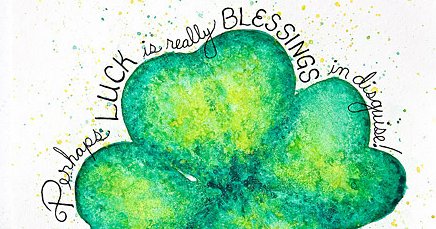 Lucky and Unlucky Days
Lucky and Unlucky Days
You might want to plan moving, traveling, major purchases, court dates, and weddings around these dates, avoiding the unlucky days and utilizing the lucky ones.
- These are the lucky days in November:
5, 14 and 20. - These are the unlucky days in November:
3, 6, 9, 10 and 21.
Fatal Days
The fifth bears stings of deadly pain,
The third is in destruction’s train.
 Holidays and Holy Days
Holidays and Holy Days
Many of the holidays begin on the eve of the night before and end on the eve of the day of. It’s also important to remember that the dates of archaic festivals and feast days may vary widely depending on the source.
November 1
- 1: Samhain
- 1: Beltane (Southern Hemisphere)
- 1: Day of the Dead
- 1: Dance of the Devils
- 1 » Day of Ekadashi (Hindu)
- 1: Pomona’s Day see also Aug 13
- 1: La Mas Ubhal – Day of the Apple Fruit
- 1: All Saints Day
November 2
November 3
November 4
- 4 thru 17: Ludi Plebeii
November 5
- 5 » The Noumenia
- 5: Bonfire Night – Guy Fawkes Night
November 6
November 9
- 9 thru 10: Mawlid an Nabi – Islam
November 11
- 11: Lunantishees Day – Celtic Faery Day
- 11: Veteran’s Day – Hero’s Day
November 12
- 12: Festival of Odin
November 13
- 13: Ides of November – Epulum Jovis
- 13 » See A Real Fox Wedding Today
- 13 or 15: Festival of Feronia
November 15
- 15 » Day of Ekadashi (Hindu)
- 15: Seven Five Three Festival for Children – Shichi-go-san (Japan)
- 15 thru Dec 24: Nativity Fast begins
November 16
- 16: Depina Hekates ~Night of the Crossroads
November 19
- 19 » The Feast of Baba Yaga. On the full moon of November, the supreme crone goddess of old Russia is honored with a feast day.
November 21
- 21 » Stir Up Sunday – last Sunday before Advent
November 24
- 24: Brumalia
November 25
- 25 » Thanksgiving Day
- 25 or 26: Day of the Covenant
November 27
- 27: Feast of Ullr
November 28
- 28: The Rural Dionysia – Festival of Dionysus
- 28 » Advent Sunday
November 29
- 29 » Dakini Day (Tibetan)
- 29 thru Dec 6 » Hanukkah
November 30
- 30: Andrzejki: Feast of love Divinations
- 30: Festival of Hecate Trivia (The night of the crossroads.) see also Nov 16
- 30 » Day of Ekadashi (Hindu)
 Saint Days
Saint Days
There is a surprising amount of magick associated with Saint days. This is a very short list of the Saint days in November, there are many many more. As time goes by I may end up listing them all, but for now, this is what I have.
- 11: Martinmas – Feast of Saint Martin
- 30: St. Andrew’s Day
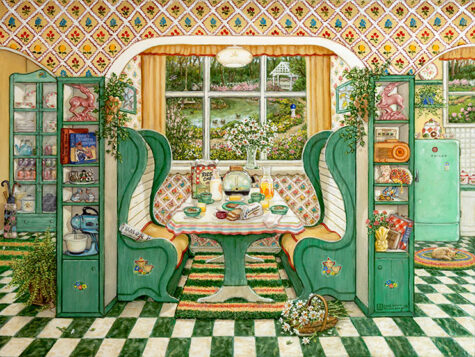 Recipes For November
Recipes For November
- All Soul’s Day Soup – All Soul’s Day
- Ossi di Morto – Day of the Dead, All Soul’s Day
- Pan de Muerto – Day of the Dead, All Soul’s Day
- Sugar Skull Recipe – Day of the Dead
Many more seasonal recipes, including recipes for new and full moon ceremonies, ancient Greek and Roman holidays, Asian festivals and etc can be found here: Seasonal Recipes.
 Notes:
Notes:
Any November lore, almanac, astrological, and celebration dates that have been shared after this post was published can be found by searching the November posts to see what’s new.
A lot of work went into this post. It was compiled from various sources by Shirley Twofeathers for The Pagan Calendar, you may repost and share without karmic repercussions, but only if you give me credit and a link back to this website. Blessed be.
The celebration of Samhain, now known as Halloween, occurs during the Reed Moon. To the Celts this month hailed the end of the year, a time to cull the livestock and to connect with ancestors. All around the world festivals that honor the dead are celebrated. During the Reed Moon, light a candle for loved ones who have died and you may receive a message from the spirit world.
- Date: October 28 – November 23
- Celtic Oghum Name: Ngetal, Negetal (pronounced nyettle)
- Themes: Healing, Home, Magick, Invisibility.
Reed Month is a good time to use divination to gain insights into the year that has passed. Perform energy work that will release old energy, burn symbols of illness on your bonfire on November the 5th during your Guy Fawkes celebrations. Remember the Celtic year does not begin until the Winter Solstice so use this interval to dream, not to make plans for the future.
Reed is typically used to make wind instruments, and this time of year, its haunting sounds are sometimes heard when the souls of the dead are being summoned to the Underworld. This is a time for divination and scrying. If you’re going to have a seance, this is a good month to do it. This month, do magical workings related to spirit guides, energy work, meditation, celebration of death, and honoring the cycle of life and rebirth.
Ngetal is the month of the Reed. This is the time of the Elm moon, and is the time when the dead are being summoned to the Underworld. This is usually the time when seances are held, and is also the perfect time for divination and scrying.
Try bringing some Reed magick into your life with these traditional examples.
- Leap over a small bonfire to leave behind the old year.
- Eat an apple on Samhain at midnight to dream of your spirit guide.
- Carve out a turnip or pumpkin as a lantern of protection.
- Bury an apple at a crossroads as an offering to the spirits of the dead.
- Use the runes for divination or to gain insight into your current situation.
Harness the power of the plant of protection and divination during this lunar month. Using Reed energy can help you to connect with your ancestral roots or let go of the past.
Reed the Inquisitor
The one that keeps secrets between the tree signs of the Celtic horoscope is the Reed. This sign can dig deep to find the real meaning of things and discover the truth. People born under this Celtic tree sign love a good story, gossip and scandals. This makes them perfect historians, journalists, detectives, and archaeologists. They have the ability to find the core of things and strip every layer of the story. However, they tend to be a bit manipulative at times, but still have a strong sense of truth and honor. Suited companions for this curious sign are other Reeds, Ash or Oak signs.
Reed individuals are complex, tenacious and fearless. Proud and independent, they have great strength of character and will rarely compromise, believing they have a role to play which excludes any signs of weakness or the luxury of “sitting on the fence.” Reed people are forceful and thrive on challenges, holding an innate belief in their own destiny.
Possessed with a powerful presence and a great deal of personal magnetism, Reed individuals attract most people but tend to repel the overly-sensitive. They are never found lacking in the ability to surmount even the most overwhelming odds. Due to their power, however, they must follow a narrow line of virtuous morals. If that line is strayed from, then they can become very dangerous people.
They are known as the great survivors of life but often meet with the hostility of others rather than the offer of a helping hand. It is necessary for Reed individuals to unite a sense of purpose with their strong will in order to prevent a path toward self-destruction.
Note:
In Celtic times, the Fern was associated with the ‘ngetal’ ogham – but there is actually some confusion over which plant or tree the ogham letter ‘ngetal’ actually refers to. Occasionally it is thought to refer to dwarf elder. The Reed Moon is sometimes referred to as the Elm Moon by modern Pagans.
The Ogham Tract text, which dates from the 12th century, links Fern to the ngetal ogham – but the earlier Scholars Primer links the ngetal ogham to broom.
Though often used with great imprecision, the term “Reed” as it applies to the Ogham is the Common Reed or Broom, a giant grass with stems which can grow to be 12 feet tall. It is found in abundance in the British Isles, usually in marshy areas where it often forms dense stands and blooms with yellow pod-shaped flowers. As with most other grasses, the vertical stems of the Reed (which can be very thick and strong) live only for a single year, dying in the Autumn to be replaced with new green shoots in the Spring. The dead stems have a tendency to rattle and whisper in late Autumn winds.
It is likely that a specific plant was less important here than the use which the broom, Reed, or Fern could be put to, which uses were very similar, including thatching, fuel, bedding, compost or mulch.
Reed Magick and Lore
The Reed grows in silence, thin and slender, by watersides and marshlands, standing in clumps at the edge of rivers. It is representative of arrows that fly up into the unknown air to land at the very source of that which is being sought, symbolic of the direct approach required when confronting a dilemma…whether that dilemma comes from within or without.
The Reed expressed the desire to search out basic truths and was also symbolic of music. Within many woodwind instruments, the Reed will create a balance.
In the past, the Reed was used to make swift-flying arrow shafts that slew both enemies and game. In this way the plant was linked to the season of death and sacrifice, in which trees shed their leaves and the energy of nature became more introspective. Many early musical instruments also used the Reed to create a haunting sound that has been connected to rites for the dead and the summoning of spirits.
Other traditional uses for Reed include thatching. Rooftops were thatched with reeds, and as the Celts withdrew into their homes for the winter they honored the plant that gave them shelter, making the Reed a symbol of royalty and protection.
The Reed is flexible, versatile, and teaches us lessons of connectivity and working together. Like a few others, the Reed is not considered a tree by our modern definition. The Druids considered anything with a thick or woody stalk to be part of the tree grouping and the Reed was considered very important. Reeds were used to weave baskets and make roofs for houses, demonstrating both flexibility and protective qualities.
As the night winds blew through the reeds, the Celts would listen and try to interpret the “otherworld” voice and it’s message.
The Druids believed the Reed to be a tree because of its dense system of roots. Cut reeds were used as pens and symbolized wisdom and scholarship. Identified with the submerged or hidden Dryad, the Reed was representative of the mysteries of death. It was associated with being both a savior and a custodian as well as a symbol of royalty.
Protection charm
Use this Reed charm to protect yourself from negativity. You will need:
- Freshly cut Reed
- A black ribbon
Visualize yourself within a circle of white light. Tie a knot into a freshly cut Reed, as it will be more flexible, and then say, “Royal Reed, plant of protection, keep me safe until the new year”.
Suspend the knotted Reed from the ceiling using the black ribbon. At Christmas, take down the charm and burn it.
Sources:
In the Old Icelandic Calendar, winter begins on the Satyrday between Hunting 11th and 17th. This festival marks the beginning of winter, which was often celebrated around the middle of October. Winter Nights celebrates the bounty of the harvest
- Also referred to as: Vetrablot, Vetrnætr, Winterfylleth, Veturnætur, Winter Finding, and Winter Day.
Winter Nights is a more accurate term, considering that the passage of time was marked by nights, not days. An example of this can be seen from Anglo-Saxon times as it applies to the English word ‘fortnight’ as a reckoning of time for two weeks.
Just as traditional Jewish sabbat begins at sundown on Friday until sundown on Saturday… it appears that the festivities traditionally kicked off at night. This allows participants to work to prepare for the party during daylight hours too. On occasion you may even see reference to the term Winter Finding.
Some groups use this as being synonymous and interchangeable with the term Winter Nights. But others will call the harvest celebration at the autumnal equinox Winter Finding, and call the later October celebration Winter Nights instead.
Though we know the various names of the holiday, we don’t really know how people celebrated Winternights. Some people honored Freyr at this holiday, where He was given a sacrifice to thank him for the year’s harvest.
Some traditions honor Freya and the fertility and protective spirits called Disir, that She leads (often the Disir are seen as our female ancestors). Glory is given to Freya, a libation of ale, milk, or mead was poured into the soil as an offering to the Disir and the Earth itself.
We know that in Sweden, an event called an Alfarblot was held around the same time of year. It was a private event where ale was served and livestock were likely sacrificed. As Freyr is the lord of Alfheim, this event may be related to Winternights.
Some people honored Odin instead; some honored the dísir (female ancestors), some honored the alfar (elves; or male ancestors). Some people likely did a mix of all of the above.
When celebrating Winternights with a definite disir/alfar focus. Food is shared at a potluck based on recipes passed down to us from our ancestors or foods that they preferred. A sumbel is in their honor, honoring specifically those who have passed on in the last year, both animals and humans, and then sharing the stories of the food we brought, and of our ancestors of blood and of spirit. This can be an intimate, moving ritual, and a great way to start the winter season.
- A Sumbel is a formal drinking ritual composed of toasting, hails, oath-taking, the recitation of poetry or song, and other forms of verbal expression.
A Winternights sumbel might start with a round to Freyr to thank Him for the past harvest and to ask for prosperity in the days ahead. A round is included for the recently departed and for our ancestors of blood and of spirit as well.
So today we have a range of practice as it applies to this time of year. Some opt to celebrate it at the time of the autumnal equinox for sheer simplicity. But many others will instead decide to observe Winter Nights in October as that’s more in keeping with the traditional calendars.
Others split the celebration up, observing a Harvest-tide celebration in September, and then in October they will instead opt to specifically come together to honor the ancestors.
If you have children, incorporating ancestor veneration at this time helps to sync up to the Halloween and Day of the Dead décor that is on the market, and allow the children to have some similar dialogue among their peers at school. What Winternights does have in common with modern Samhain and Day of the Dead traditions, is that we both honor ancestors with their favorite foods and drink.
A Blot for Winternights
I hope all Heathens have a satisfying Winternights for both the living and the dead this year . Hail the disir! Hail the alfar! Hail Freyr!
- Hallowing:
Thunar, Guardian of Asgard and Midgard, We ask you to ward this stead well for Winternights. Hail Heimdall warder of Bifrost we ask that you hold us in your great sight.
- Purpose:
We gather to honor the Aesir and Vanir on this Winter Night and give thanks for the fruits of this past year and the Harvest we have gathered from the Earth. We also look back on the past year and measure our time that it was used wisely; to look at the future to find our way; like the Ice of time scrubbing away the impurities to leave behind the clear work.
We ask the dwellers of Asgard to give us the strength to and to help us provide for our kinsman in preparation for the long Winternachten yet to come.
- Hails:
Hail Wodan, The All Father, for your wisdom and forethought in guiding us forward through the winter to come and for the knowledge you have shared with us.
Hail Wodan!
Hail to Fro Ing for the bountiful harvest you have brought to us this eve.
Hail Fro Ing!
Hail to Freya for the love and life we hold to our hearts.
Hail Freya!
Hail to all the Ases and Wanes for the mighty work that you do.
Hail the Ases and Wanes!
And Hail to our Ancestors and Wights of the land. Hail to the All who have crossed Bifrost before.
Hail the Ancestors!
- Welcoming:
We welcome all the Ases and the Wanes. We welcome all the Wights, Alfs and Ancestors who have gone before us. We Welcome all the Wights and Landvaetter to witness this rite rightly done so that you shall see the truth in our hearts.
Heilsa all!
The time of Winternights marks the passing of Sunna farther down into the sky. This time of year marks the Mother Earth going to sleep to be rested for the coming Spring; for Fro Ing to renew the fertility of the Earth to bring forward the crops of our folk.
We look forward to Yule that is fast approaching. And we honor our ancestors that have gone before us. We look back over this past year with pride of the work rightly done. We look forward to prepare for the coming of winter, to protect our hearth and Kin from the cold of the frost giant called Winter, to open our hearths to those in need.
With this hallowed drink, brewed with the hand of Aegir the Brewer of Asgard we give our toasts:
- Wassail All!
Hail to the Aesir and Vanir!
Hail to the Alfs and the Dises!
Hail to our Ancestors!
Hail to the Landvaetter and all Wights of weal!
We now offer this sacrifice and return it to the Earth.
- Personal Hails!
Heilsa!
- The Blessing and Ending
We thank the Gods and Goddesses, the Aesir and Vanir for the gifts that we have and the gifts we may receive, May you find us fitting to receive them.
Heilsa All!
Sources:
- Asatru Utah
- Patheos
- Wyrd Designs
- Erich Shall
- Grundair Karlson
According to astrological and lunar lore, there are best days for doing a variety of tasks. The best days listed here are based on both the phase of the moon and its position in the zodiac. Many people believe that if you do the tasks on the dates listed, you will get the best results possible.
November 1:
- Bake
- Castrate Farm Animals
- Cut Firewood
- Cut Hair (to increase growth)
- Dig Holes
- Mow Grass (to increase growth)
- Plant Above Ground Crops
- Potty Train a Child
- Wax Floors
- Wean a Baby or an Animal
November 2:
- Bake
- Castrate Farm Animals
- Cut Firewood
- Cut Hair (to increase growth)
- Dig Holes
- Mow Grass (to increase growth)
- Plant Above Ground Crops
- Potty Train a Child
- Wax Floors
- Wean a Baby or an Animal
November 3:
- Castrate Farm Animals
- Cut Firewood
- Dig Holes
- Kill Plant Pests
- Mow Grass (to increase growth)
- Paint
- Potty Train a Child
- Wean a Baby or an Animal
November 4:
- Castrate Farm Animals
- Cut Firewood
- Dig Holes
- Kill Plant Pests
- Mow Grass (to increase growth)
- Paint
- Potty Train a Child
- Wean a Baby or an Animal
November 5:
- Castrate Farm Animals
- Cut Firewood
- Cut Hair (to increase growth)
- Dig Holes
- Get Married
- Mow Grass (to increase growth)
- Plant Above Ground Crops
- Potty Train a Child
- Set Eggs
- Start Diet (to gain weight)
- Wax Floors
- Wean a Baby or an Animal
November 6:
- Castrate Farm Animals
- Cut Firewood
- Cut Hair (to increase growth)
- Dig Holes
- Get Married
- Mow Grass (to increase growth)
- Plant Above Ground Crops
- Potty Train a Child
- Start Diet (to gain weight)
- Wax Floors
- Wean a Baby or an Animal
November 7:
- Castrate Farm Animals
- Cut Firewood
- Cut Hair (to increase growth)
- Dig Holes
- Get Married
- Mow Grass (to increase growth)
- Plant Above Ground Crops
- Potty Train a Child
- Start Diet (to gain weight)
- Wax Floors
- Wean a Baby or an Animal
November 8:
- Bake
- Cut Firewood
- Dig Holes
- Kill Plant Pests
- Mow Grass (to increase growth)
November 9:
- Bake
- Cut Firewood
- Dig Holes
- Kill Plant Pests
- Mow Grass (to increase growth)
November 10:
- Advertise Something for Sale
- Cut Firewood
- Cut Hair (to increase growth)
- Dig Holes
- Get Married
- Mow Grass (to increase growth)
- Paint
- Plant Above Ground Crops
- Wax Floors
November 11:
- Advertise Something for Sale
- Cut Firewood
- Cut Hair (to increase growth)
- Dig Holes
- Get Married
- Mow Grass (to increase growth)
- Paint
- Plant Above Ground Crops
- Wax Floors
November 12:
- Advertise Something for Sale
- Ask For a Loan
- Dig Post Holes
- Make Jams and Jellies
- Mow Grass (to slow growth)
- Paint
- Slaughter
- Transplant (seedlings and plants)
November 13:
- Cut Hair (to slow growth)
- Kill Plant Pests
- Mow Grass (to slow growth)
- Quit Smoking
- Set Eggs
- Slaughter
- Wash Wooden Floors
November 14:
- Cut Hair (to slow growth)
- Kill Plant Pests
- Mow Grass (to slow growth)
- Plant Root Crops
- Quit Smoking
- Set Eggs
- Slaughter
- Wash Wooden Floors
November 15:
- Brew
- Can Fruits and Vegetables
- Hunting
- Mow Grass (to slow growth)
- Plant Flowers
- Plant Root Crops
- Plant Seed Beds
- Transplant (seedlings and plants)
November 16:
- Brew
- Can Fruits and Vegetables
- Hunting
- Mow Grass (to slow growth)
- Plant Flowers
- Plant Seed Beds
- Transplant (seedlings and plants)
November 17:
- Ask For a Loan
- Cut Hair (to slow growth)
- Demolition
- Dig Post Holes
- Dry Fruits and Vegetables
- Kill Plant Pests
- Mow Grass (to slow growth)
- Paint
- Pick Apples and Pears
- Quit Smoking
- Start Diet (to lose weight)
- Wash Wooden Floors
November 18:
- Ask For a Loan
- Cut Hair (to slow growth)
- Demolition
- Dig Post Holes
- Dry Fruits and Vegetables
- Kill Plant Pests
- Mow Grass (to slow growth)
- Paint
- Pick Apples and Pears
- Quit Smoking
- Start Diet (to lose weight)
- Wash Wooden Floors
November 19:
- Harvest
- Kill Plant Pests
- Mow Grass (to slow growth)
- Plant Root Crops
- Quit Smoking
- Start Diet (to lose weight)
November 20:
- Harvest
- Kill Plant Pests
- Mow Grass (to slow growth)
- Plant Root Crops
- Quit Smoking
- Start Diet (to lose weight)
November 21:
- Cut Hair (to slow growth)
- Get Married
- Mow Grass (to slow growth)
- Plant Flowers
November 22:
- Cut Hair (to slow growth)
- Get Married
- Mow Grass (to slow growth)
- Plant Flowers
November 23:
- Cut Hair (to slow growth)
- Get Married
- Mow Grass (to slow growth)
- Plant Flowers
November 24:
- Can Fruits and Vegetables
- Make Jams and Jellies
- Mow Grass (to slow growth)
- Plant Seed Beds
- Prune Trees
- Transplant (seedlings and plants)
November 25:
- Can Fruits and Vegetables
- Make Jams and Jellies
- Mow Grass (to slow growth)
- Plant Root Crops
- Plant Seed Beds
- Prune Trees
- Transplant (seedlings and plants)
November 26:
- Advertise Something for Sale
- Castrate Farm Animals
- Cut Firewood
- Dig Holes
- Kill Plant Pests
- Mow Grass (to increase growth)
- Plant Root Crops
- Potty Train a Child
- Travel (for pleasure)
- Wash Windows
- Wean a Baby or an Animal
November 27:
- Advertise Something for Sale
- Castrate Farm Animals
- Cut Firewood
- Dig Holes
- Kill Plant Pests
- Mow Grass (to increase growth)
- Potty Train a Child
- Travel (for pleasure)
- Wash Windows
- Wean a Baby or an Animal
November 28:
- Bake
- Castrate Farm Animals
- Cut Firewood
- Cut Hair (to increase growth)
- Dig Holes
- Mow Grass (to increase growth)
- Plant Above Ground Crops
- Potty Train a Child
- Wax Floors
- Wean a Baby or an Animal
November 29:
- Bake
- Castrate Farm Animals
- Cut Firewood
- Cut Hair (to increase growth)
- Dig Holes
- Mow Grass (to increase growth)
- Plant Above Ground Crops
- Potty Train a Child
- Wax Floors
- Wean a Baby or an Animal
November 30:
- Castrate Farm Animals
- Cut Firewood
- Dig Holes
- Kill Plant Pests
- Mow Grass (to increase growth)
- Paint
- Potty Train a Child
- Wean a Baby or an Animal :
Source: The Farmer’s Almanac
The Dance of the Devils (La danza de los diablos) is a dance performed in Costa Chica, the Pacific coast of Guerrero and Oaxaca in Mexico. As part of the ‘Day of the Dead’ festivities celebrated on the last days of October and the first days of November in Mexico. Its purpose is not so much to terrify however as to amuse and draw the community together while paying reverence to the spirits of the dead on the Day of the Dead.
Men dressed in rags and high boots perform the Dance of the Devils in Afro-Mexican communities. During these celebrations young men dress up as cowboys or as dead people, in which case they wear dusty clothes covered with terrain (to represent the passage of time and the fact of being buried underground). Their faces are covered with masks made of leather or paper with long beards and hair. A black beard represents a young devil, a white beard represents an old one. A small pair of goat or deer horns crowns the mask.
The men dance through different villages on All Souls Day, making noise and playing with children and young people by flogging them with a whip.
An elder diablo called el Terron, and a female diabla called la Minga, who carries a baby doll, lead the dancers. The elder diablo plays and whips the other diablos into dancing and chases la Minga around with the whip because she interrupts the concentration of the devil dancers. One way that la Minga attempts to disrupt the other dancers is by seduction, the Minga also tries to give her doll, which is a symbol of her productive power, to the dancers or to anyone in the audience, seeking a father to her ‘baby’.
The face of the men performing the dance is covered with a leather deer mask with horns and An elder devil, called Tenango, whips the other devils during this performance. Groups of 24 dancers (the devils) stomp and twirl in rows or circles along the streets; eventually, they stop at the houses where the owner gives them money or food for dancing.
Origins of the Dance of the Devils:
The Dance of the Devils is part of the ceremonial commemoration of the dead. It is a celebration of colonial origin, which was introduced by the black people of the Costa Chica of Guerrero and Oaxaca, who were brought there as slaves by the Spanish colonizers to work in mines, cotton plantations and cattle ranches.
From Río Grande, in the town of Tututepec, on the Oaxacan coast, to Tenango, in the municipality of Azoyú, to the north, this dance recalls the past times when ranchers or cowboys used the whip as well as trumpet to groups of wild cattle in order to force them to cross the Sierra Madre del Sur, to reach the plateau and sell the animals.
The Devils in the Mexican dance also use the whip, and behave according to the cowboy stereotype, that is, as brave and strong man. This performance, however, is also a historical memory, which becomes a ritual memory to the black population which was an intermediate caste, between the indigenous and the white land owners.
The black population who arrived in Mexico from very different lands such as Africa and the Antilles, bringing different languages and cultures, could not recreate a black culture of African traits, as could happen instead, to various degrees, in other Afro-American regions. These people therefore in their segregation from festivities and public celebrations organized by the masters of the haciendas, used to perform their own festivities secretly, by performing rituals to their African gods, playing drums and dancing.
At the same time, however, they borrowed elements of some indigenous and Catholic traditions and readopted them – with imagination and joy – to overcome the pain of domination and the humiliation of banishment.
It is no coincidence that the celebration of their ancestors is performed through the cowboy/devil figure. In this dance the ritual action harmonizes gestures and words. Devils are the dead who revive to do mischief, to steal, to sow fear and laughter. The dance could also be called the ‘Devil’s Game’, a game designed to laugh at the forbidden: a capataz (a boss), a bad mother, or a violent and bossy father.
The function of the Dance of the Devils, from a social aspect, is to cleanse and protect the community from spirits that carry evil energy. It can be viewed a way to control evil. In a sense, the dance is used to call the tono spirits of the ancestors to heal the community similar to the way an individual might be healed; the masks and the boite drum call the spirits and the dance is the mode of healing. Trance possession, another traditional healing mode, is also part of these dances, as a means to form a connection between the spiritual and material.
The dancers use their bodies to bring the spirits and form a bond between them and the community. “As they dance, they create an aura, which begins to rise and cover everyone who is sitting there. ” Even the children will come and sit quietly and watch. The force, she says, starts in the dancers’ hands and continues through their feet, legs, hips, shoulders, and faces until they are entirely transformed. The wearing of the tono masks allows them to achieve a more powerful transformation.
About The Dance:
The dance itself is strikingly similar to the egungun dances of West Africa; the performance is a form of ancestor reverence, and similar dances that may be seen throughout the Diaspora (the dispersion of the people from their original homeland). While the Dance of the Devils occurs within a context that includes European and Native influences, the core of the dance, its meaning and specific elements, are African.
The Dance of the Devils can be traced to Europe during the Middle Ages, but according to an Afro-Mestizo elder, the devils are spirits of the dead and not devils in search of souls. They are actually ancestral spirits whose presence is celebrated and encouraged. Similar to a dance performed by the Abakua in Cuba, dressing as a diablo (devil) symbolizes the willingness to allow the spirit to possess your body.
The egungun masquerades of West Africa are, like the Dance of the Devils, performed as part of a feast of the dead. Masks are worn which represent the dead, symbolically, but not as individual persons; flogging with whips is intended to promote growth and maturity in young men and fertility in women. The egungun dances were a strong social force in the societies where they originated, especially in times of unrest or external threat.
Another similarity is that while only men generally perform the dances, there is often at least one woman who either participates on some level or teaches the dance.
It has been suggested that the presence of the whip is a reference to the relationship between the former slaves and their overseers. However, the presence of flogging in the egungun dances of West Africa, when compared to Nana Minga and her baby, suggests that flogging is another African retention and bears its original symbolic meaning of fertility and protection against evil spiritual energy.
The dance being performed on the Day of the Dead leads one to think that the dance relates to the supernatural world of the spirits. The fact that the dancers dress in cowboy clothes and wear masks made of horse hair may be interpreted to mean that the dance represents the spirits of dead cowboys, the employment of many of the Afro-Mestizos cimarron ancestors. However, the masks, which appear animal-like, may in fact represent the tono spirits of ancestors, an idea supported by the presence of the boite drum.
The boite or bute, is a large gourd with a goatskin head; the drum is played by moving a stick through a hole in the center to create a vibration, not by striking. It is very similar to a drum used by the Abakua, an all-male secret society in Cuba, and is described in a similar fashion, as having the voice of a big cat, a leopard or jaguar, because of the roaring sound it makes.
When attempting to heal someone of sickness Afro-Mestizos call the animal tono of the sick person. Finding the person’s tono is a way to determine if the sickness is caused by the animal’s death. Healers in attempt to cure a person called the leopard, using the roaring sound of the boite drum to simulate the voice of the big cat.
Sources:
Dakini day, celebrated on the 25th day of each lunar month in Vajrayana Buddhist traditions, celebrates the feminine energy of wisdom. Devoted Buddhists will celebrate with a Tsok (Tsog), a feast including food, singing, a group (or single) sadhana full of sound and celebration. Most Tibetan Buddhist temples and meditation centers try to arrange a monthly Tsog on this day each month, with celebrants bringing food as offerings. It is always a happy day, that invites blessings not only for the attendees, but for all sentient beings.
This is one of the special days during a month, when Vajrayana practitioners perform a ritual of offering and purification of their commitments. It is believed that on this particular day, all the Dakinis gather in special sacred places and their energy is potently vivid and present at that moment.
When we perform practice on those auspicious days, we can connect with this potent energy and thus gain a lot of merit. It allows us to develop our practice and capacities, as well as purify our defilements and mistakes that we have accumulated with time. In this way, Dakini Day becomes very important for Vajrayana practitioners.
What is a Dakini?
The Dakini is a female being of generally volatile temperament, who acts as a muse for spiritual practice. Dakinis can be likened to elves, angels, or other such supernatural beings, and are symbolically representative of testing one’s awareness and adherence to Buddhist tantric sadhana.
Dakinis are portrayed as elusive, playful and often fierce and naked to symbolically convey how elusive true Wisdom encompassing “Emptiness” can be.
Without contradiction to their role as exemplars of Emptiness, Dakinis can also represent fierce activities, such as protection — the ferocious protective love of a mother.
Khandro Rinpoche defines the authentic Dakini principle as “a very sharp, brilliant wisdom mind that is uncompromising, honest, with a little bit of wrath.”
Dakinis appear in many forms. “The Dakinis are the most important elements of the enlightened feminine in Tibetan Buddhism,” says American teacher Tsultrim Allione. “They are the luminous, subtle, spiritual energy, the key, the gatekeeper, the guardian of the unconditioned state. If we are not willing to invite the Dakini into our life, then we cannot enter these subtle states of mind. Sometimes the Dakinis appear as messengers, sometimes as guides, and sometimes as protectors.”
Dakini are timeless, inorganic, immortal, non-human beings who have co-existed since the very beginning with the Spiritual Energy. In some New Age belief systems, they are angelic. This New Age paradigm differs from that of the Judeo-Christian by not insisting on angels being bona fide servants of God.
Moreover, an angel is the Western equivalent of a Dakini. The behavior of Dakini has always been revelatory and mysterious; they respond to the state of spiritual energy within individuals. Love is their usual domain – one explanation for Dakini or angels supposedly living in the sky or heaven. Manifestations of Dakini in human form occur because they supposedly can assume any form. Most often they appear as a human female. By convention, a male of this type is called a ‘Daka’.
In Buddhism, typically, the male Buddhas represent compassionate means, while the female Buddhas represent Wisdom. The symbols of bell and vajra (Ghanta and Dorje) represent female wisdom — the bell, which makes the sound of “Emptiness” — and the Vajra, representing compassionate means.
Dakini’s have always been a part of Buddhism, starting with the Jataka’s (stories of Buddha’s former lives) in which “divine beings are described as travelling through the air. In Sanskrit, such a being is called a Dakini, a term generally translated as “space-goer,” “celestial woman,” or “cloud fairy.”
Dakinis are typically thought of as the emanation of the “Enlightened Mind” understanding Emptiness. Another concept usually tied to Dakini practice is “bliss” — the state of blissful awareness of emptiness.
It is a wonderful experience to have a moment that realizes emptiness, a feeling of joy-bliss rather than “nothingness.” This is why Dakinis are often portrayed as active, dancing, joyful or fierce, naked and unencumbered.
Five Dakini Healing Mantra
The meaning of Dakini is the female enlightened energy and the awakened state of consciousness. Therefore, chanting this mantra increases and enhances all enlightened feminine energy.
Bam Ha Ri Ni Sa
The 5 Dakini also represents each of the 5 Elements:
- BAM ~ Buddha Dakini ~ (blue) ~ Mind energy, pacifies Ignorance
- HA ~ Vajra Dakini ~ (white) ~ Body energy, pacifies Anger
- RI ~ Ratna Dakini ~ (yellow) ~ Knowledge/Qualities/Healing, pacifies Ego/Pride
- NI ~ Padma Dakini ~ (red) ~ Speech energy, pacifies Desire
- SA ~ Karma Dakini ~ (green) ~ Action/Removes Obstacles, pacifies Jealousy
This mantra is helpful for all female related health issues, transforms negative emotions, unblocks channels, and balance 5 elements. When chanting this mantra on Dakini Day, the power magnifies ten-fold!
After chanting, blow into a glass of water, which infuses the healing vibration into the water, drink, and continue to enjoy its healing properties.
Sources:
Most stories advise against seeing a fox wedding—foxes are powerful in Japanese folklore, but dangerous. A wise person keeps well away, and getting wrapped up in Kitsune magick is rarely healthy in Japanese folklore.
If you remain undeterred, and really want to see a Fox Wedding, according to the folklore of the Fukushima Prefecture, it can be done, but only on the 10th day of the 10th month of the Lunar Calendar. (In 2019, this falls on November 6).
- Here’s what to do:
Wear a suribachi mortar on your head and stick the wooden pestle in your belt. Then stand under a date tree. The length of time is unspecified… I’m assuming for however long it takes.
Aichi prefecture has a much easier method—just spit in a well and weave your fingers together. You are said to be able to view the Kitsune no Yomeiri though the gaps in your fingers.
More about the Fox Spirits known as Kitsune can be found at The Powers That Be, a story about a fox wedding can be found on Widdershins. A Fox Wedding festival is held annually in Japan on November 3rd. You can read about that in The Pagan Calendar.
Source: Hyakumonogatari Kaidankai

